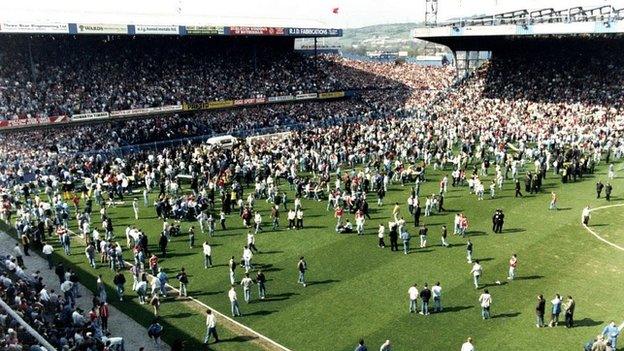Hillsborough inquests jury visits stadium
- Published

The jury visited places in Sheffield "pertinent to the inquests"
The jury at the Hillsborough inquests has been taken to the Sheffield stadium for a site visit.
Jurors walked down the tunnel of the Leppings Lane stand, where a crush led to the deaths of 96 Liverpool fans.
Since the 1989 disaster, the ground has seen substantial changes, including the removal of terraces and metal fencing.
The eleven jurors also visited other places relevant to the inquests as set out by the coroner, including a pub and a railway station.
A bus carrying the jury stopped on Leppings Lane, a road adjacent to the stadium. The jurors then walked towards Hillsborough.
The coroner Lord Justice Goldring told them: "This is where supporters would have walked."
He reminded the jury that the layout of the entrance had changed, with former exit gates and other features marked off with cones.

Cones were used to mark out the former features of Hillsborough stadium
Jurors were then taken down the tunnel to the former location of pens three and four, where the fatal crush occurred.
Those present carried photographs of the stadium in 1989 to help visualise the old layout.
They were also shown the police control box, which is "much larger" than its 1989 counterpart, and Sheffield Wednesday's club shop, which stands on the site of the former gymnasium used in the disaster as a temporary mortuary.
'All being recorded'
Jurors were taken to two locations en route to the stadium - the White Horse Inn, where Lord Justice Goldring said "some Liverpool fans" went before the match, and Wadsley Bride railway station, from which he said supporters "were accompanied by police as they went to the stadium".
The coroner, wearing a microphone, told the jury: "We are, as it were, in court. That's why this is all being recorded."
The convoy also visited the Northern General and Royal Hallamshire Hospitals, which both took casualties on the day.
The coroner said the Northern General accepted 88 casualties, "a number of whom obviously died", while 71 went to the Royal Hallamshire where "obviously not all died".
Earlier this week the inquests heard a minute-by-minute countdown of how the disaster unfolded.
The hearing was told of key events and viewed rarely seen footage of the day taken by police and BBC cameras as well as stadium CCTV.
The fresh inquests into the deaths were ordered when a panel of three High Court judges quashed the accidental death verdicts.